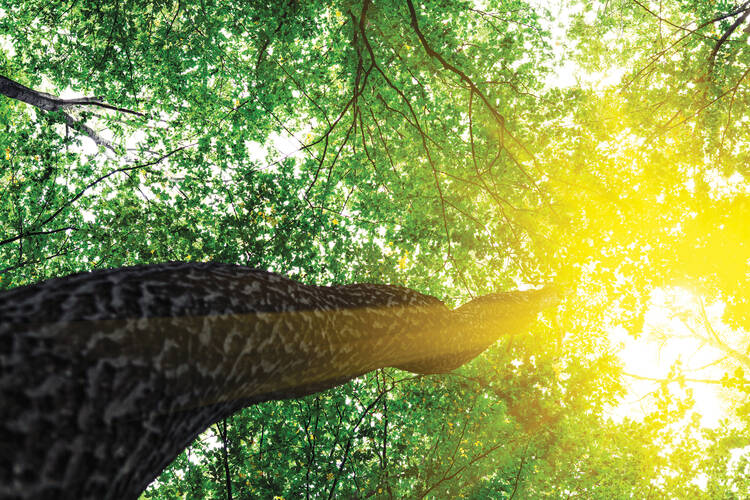The park buzzes with activity as the Mediterranean sun bathes throngs of tourists in warmth. I am leaning against a tree, staring up at the spreading branches. They remind me that I always feel close to God when I examine his creation, and as breathtaking as man-made skyscrapers may be, no human architect could have produced the Alps or the Rockies, or even the winding boughs shading me on this November afternoon. I have often sensed God’s presence strongly in the natural world he designed.
I am preparing to visit a church, a popular pastime for the American student in Europe, especially the Catholic American student. After all, the cathedrals and basilicas across the continent are more magnificent than any in the world, and they far outshine the churches of the United States in grandeur. When I arrived in Italy at the start of my study abroad program with the University of Dallas, I enthusiastically began my tour of European churches with a stop at St. Peter’s Basilica—and I never looked back.
Now, three months later, I have experienced grandiose churches throughout Italy, from St. Mark’s in Venice to the Duomo in Florence and the major basilicas of Rome. My architecture class has educated me on Baroque and Romanesque styles; I can distinguish a transept from a triumphal arch and identify a side aisle or a colonnade. On a good day, I may even remember how to define an ambulatory.
But now, in Barcelona, every bit of neat and orderly classification, every lofty vocabulary word my professor has imparted and every past perception of a European church is about to be rendered immaterial. The ideals of Baroque and Romanesque styles will vanish from my mind, forever supplanted by the most unusual style of this unique building. I remain, for a moment, staring up at the tree branches, feeling close to God, yet I am increasingly curious about the structure across the street.
I walk toward the entrance, glancing upward, gazing at the sculpted facade and the elongated, dark spires. This is the strangest church I have ever seen. Where did the architect get the inspiration for this? What was he thinking? Have I just wasted 10 euros on the entry fee? The hum of construction equipment answers me with indifference. Tourists are pouring through the doors ahead. Is it worth it? At least if I go in, no one will scold me for having missed out on one of Barcelona’s primary attractions. I shuffle toward the door.
God, the Muse
As I look up, just before entering, I notice a sculpture of the Passion. The starkness of the carved stone conveys the Lord’s suffering to me more than any other of the Passion depictions ubiquitous throughout Italy. These are not the colorful strokes of a Baroque chapel in Florence or the mosaic of a classical Roman church. This scene is something alien, bare and plain, yet more vivid with its sharply chiseled statues than any of the vibrant paintings I had seen. The earth tones of the stone give the structure a natural quality, a blunt contrast to the otherworldly whiteness of the marble sculptures in most Baroque churches. I quickly realize there must be something to this building. I step inside.
I am staring upward at spreading branches of stone, stretching to the ceiling from perfectly carved trunks. Colors are pouring through magnificent panes of glass as the November sunlight is translated into a man-made rainbow. I pause in awe. Have I really stepped inside a building, or is the whole church some ancient forest with mighty limbs supporting the central nave? The architect, Antoni Gaudí, drew his inspiration from God’s creation when he designed this building, La Sagrada Familia. In a way, the Lord himself crafted the plans for the basilica.
As I look around the beautiful interior, I feel the nearness to God that I usually associate with being in nature. A part of me still believes I’m back in the park across the street, daydreaming as I lean against a tree. I kneel down to say a prayer near the main altar, my routine whenever I enter a church. But I have never prayed in any church quite like this. What can I say? I simply thank God for creating the natural world that served as the basis for La Sagrada Familia.
I leave the building several minutes later. As I enter into the sunlight once again, it occurs to me that we don’t always take the time to recognize the presence of God in the natural world he created. And yet God’s touch is in the mountains, rivers and even seemingly rudimentary plants and trees. There is so much there that can inspire us. Recognizing God’s magnificence in nature reminds us that he is not distant or disconnected from the world, but truly omnipresent. Antoni Gaudí recognized that and designed a church that only the Creator and Architect of the world could inspire. I continue on my journey knowing that we, too, must always look to God’s creation for inspiration, in the hope that with God’s help we can build a world infused with his grace.








